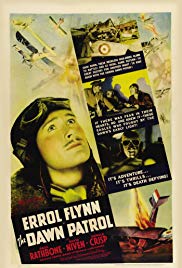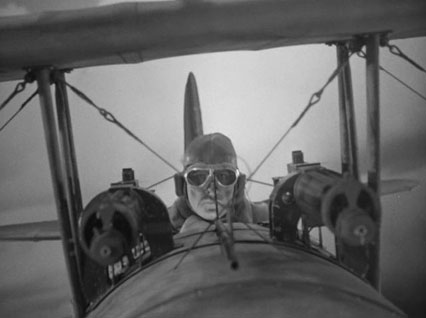THE DAWN PATROL
SUBJECTS — Aviation; World/WWI & England;
SOCIAL-EMOTIONAL LEARNING — Courage in War;
MORAL-ETHICAL EMPHASIS — Trustworthiness.
AGE: 10+; No MPAA Rating;
Drama; 1938; 103 minutes; B & W. Available from Amazon.com.
There is NO AI content on this website. All content on TeachWithMovies.org has been written by human beings.

SUBJECTS — Aviation; World/WWI & England;
SOCIAL-EMOTIONAL LEARNING — Courage in War;
MORAL-ETHICAL EMPHASIS — Trustworthiness.
AGE: 10+; No MPAA Rating;
Drama; 1938; 103 minutes; B & W. Available from Amazon.com.
TWM offers the following worksheets to keep students’ minds on the movie and direct them to the lessons that can be learned from the film.
Film Study Worksheet for ELA Classes and
Worksheet for Cinematic and Theatrical Elements and Their Effects.
Teachers can modify the worksheets to fit the needs of each class. See also TWM’s Movies as Literature Homework Project.
This film is about a British airplane squadron during the First World War.
Selected Awards:
None.
Featured Actors:
Errol Flynn, Basil Rathbone, and David Niven.
Director:
Edmund Goulding.
“The Dawn Patrol” shows aerial warfare in its infancy: the rickety planes, the dog fights, the poor training given to the British pilots, and the pressure on the officers who sent boys up every day knowing that many wouldn’t come back.
MODERATE. As one ten-year-old kept repeating as he watched this movie, “These guys drink like fish.” Niven and Fairbanks also have too much of a high old time between flights. While some men resort to drunkenness and pranks in the face of tension and likely death, this film overdoes it. The heroes also miraculously survive time and again, although reality takes hold at the end.
Describe for your child the role of air power in the First World War. See the Helpful Background section. Ask and help your child to answer the Quick Discussion Question.

World War I was the first war in which the airplane played a combat role. Planes were used both for scouting enemy positions and for bombing and strafing. Observation balloons and dirigibles were also used. Early in the war, German dirigibles bombed Paris and London, but dirigibles were too vulnerable and the Germans switched to planes. By 1915, the airplane dominated the air war. The Germans had air superiority from October 1915 until July 1916. After that, the Allies, chiefly the British, dominated. When the U.S. entered the war Allied air supremacy became overwhelming. U.S. Army Air Corps strength went from three squadrons in April 1918 to 45 in November of the same year. By the end of the war, there were 200,000 Americans active in the Army Air Corps in Europe.
World War I aerial warfare featured a number of aces, men who shot down many enemy planes. They were the American Eddie Rickenbacker, the Frenchmen Georges Guynemey and Charles Nungesser; Albert Ball of Great Britain, the Canadian William Avery Bishop and the German Baron Manfred Von Richthofen (the Red Baron).
Before World War I, balloons were used to observe enemy positions. Propeller driven planes were first used to observe enemy troops by the Italians in the Italo-Turkish War of 1911-12. The British established the Royal Flying Corps in 1912. At the beginning of World War I, the Allies and the Germans each had about 200 slow, vulnerable planes. These were soon replaced by faster planes. Early aerial combat was hampered by the fact that bullets from the machine gun mounted on the plane would strike the propeller. This was solved by Anthony Fokker, a Dutch aircraft designer working with the Germans. The Allies quickly matched this advance.
From 1916 until shortly before the end of the war, the Germans bombed Paris and London causing 9000 casualties. Their main purpose was to draw British planes from the front, to handicap British industry and to destroy the morale of the civilian population. The raids accomplished little of military value.
For more on the First World War, see Learning Guide to All Quiet on the Western Front.
1. What is the relationship between the closeness of death, the need to act courageously, and the reckless drunkenness of the flyers?
2. How does this film show how some people react to the stress of war and a very risky role in it?
Discussion Questions Relating to Ethical Issues will facilitate the use of this film to teach ethical principles and critical viewing. Additional questions are set out below.
(Be honest; Don’t deceive, cheat or steal; Be reliable — do what you say you’ll do; Have the courage to do the right thing; Build a good reputation; Be loyal — stand by your family, friends, and country)
1. Did these particular men have to be flyers and put their lives at special risk? There were hundreds of other jobs that they could take which supported the war effort but which were less dangerous.
In addition to websites which may be linked in the Guide and selected film reviews listed on the Movie Review Query Engine, the following resources were consulted in the preparation of this Learning Guide:
This Learning Guide was last updated on December 9, 2009.